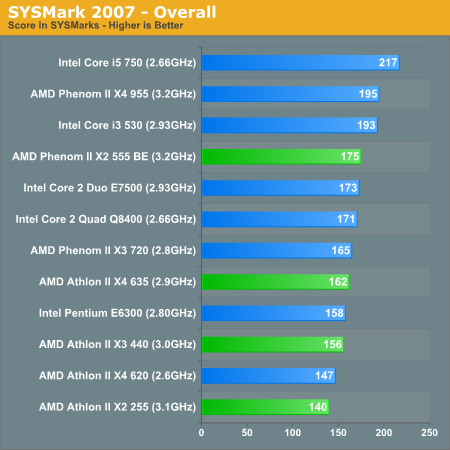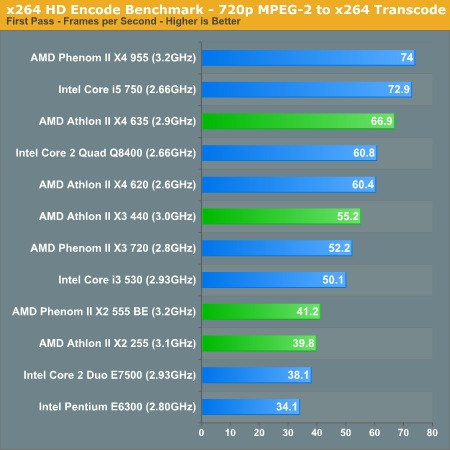AMD's New Year Refresh: Athlon II X4 635, Phenom II X2 555, Athlon II X2 255 & Athlon II X3 440
by Anand Lal Shimpi on January 25, 2010 12:00 AM EST- Posted in
- CPUs
SYSMark 2007 Performance
Our journey starts with SYSMark 2007, the only all-encompassing performance suite in our review today. The idea here is simple: one benchmark to indicate the overall performance of your machine.

Given its age, SYSMark is more of a lightly threaded benchmark by today's standards. Dual core processors (or quad-core chips with aggressive turbo modes) do quite well here. AMD's Phenom II X2 555 BE does better than anything else in its price range. The Core 2 Duo E7500 is probably a good indicator of the Pentium E6600's performance, and it just equals the perf of the 555 BE.
The triple and quad-core chips don't do that well here, there just aren't enough threads to go around.
Adobe Photoshop CS4 Performance
To measure performance under Photoshop CS4 we turn to the Retouch Artists’ Speed Test. The test does basic photo editing; there are a couple of color space conversions, many layer creations, color curve adjustment, image and canvas size adjustment, unsharp mask, and finally a gaussian blur performed on the entire image.
The whole process is timed and thanks to the use of Intel's X25-M SSD as our test bed hard drive, performance is far more predictable than back when we used to test on mechanical disks.
Time is reported in seconds and the lower numbers mean better performance. The test is multithreaded and can hit all four cores in a quad-core machine.

If you have threads and need cores, AMD has the medicine. The $119 Athlon II X4 635 handles our Photoshop test with the same elegance as Intel's Core i3 530. The Phenom II X2 555 BE and the Athlon II X2 255 are on par with the Pentium E6300 and should both be a bit slower than the E6600.
x264 HD Video Encoding Performance
Graysky's x264 HD test uses the publicly available x264 encoder to convert a 4Mbps 720p MPEG-2 source. The focus here is on quality rather than speed, thus the benchmark uses a 2-pass encode and reports the average frame rate in each pass.


For video-encoding you can't beat the value of the Athlon II X4 635. You get the performance of a quad-core Intel that will set you back another $40. The triple-core Athlon II X3 440 does well here, besting all previous generation dual-core CPUs. Only the Core i3 530 is faster, and more expensive. The Phenom II X2 555 BE and the Athlon II X2 255 perform similarly to their equivalently priced Intel CPUs.










63 Comments
View All Comments
Alouette Radeon - Wednesday, March 10, 2010 - link
I didn't want to believe it but you really ARE biased towards Intel! After all the harm they've caused in this industry how could you be? Do they threaten to stop sending you testing material if you don't sound like they're the second coming of Christ and AMD is just a second-rate company?computerfarmer - Monday, February 1, 2010 - link
Good article.Trying to find these to buy. AMD Athlon II x4 635 is the only one I have found available (newegg.ca). I live in Canada.
Are the rest of them expected soon?
th3rdpartynation - Tuesday, January 26, 2010 - link
I want to build a WHS and the 3 things I consider most important are Video Encoding performance, Low Power, and Price. That being said I have narrowed it down to Athlon II X4 vs Core i3. A matchup I would love to see would be an undervolted Athlon II X4 vs. an Overclocked Core i3. If not then maybe everybody could tell me which they recommend?blowfish - Tuesday, January 26, 2010 - link
for the video encoding part, that's easy enough - just check out "Bench", and factor in your underclocks and overclocks, since encoding scales fairly well with clock speed for a given cpu.Price is easy enough to figure out.
The i3's probably have the best power/performance.
jackylman - Monday, January 25, 2010 - link
As a fan of silent computing, the 45W TDP quad-core 910e is the most exciting chip in this round, and I don't see it in the power consumption graphs. Disappointed.. :(MrSpadge - Tuesday, January 26, 2010 - link
You see in the charts that:- idle power isn't that much different between the AMDs
- at load they consume about their "ACP" (former TDP)
So if you're not running under load the choice doesn't matter. If you run under load you could take any of the current 45 nm CPUs and lower its ridiculously high stock voltage of 1.4 V to maybe 1.2 V at 2.6 GHz. That should get you to maybe 80 W instead of 65 W for the specially binned chips. Close enough I'd say. If it's still too loud: go to 2.5 GHz and lower the voltage again.
BTW: Core i3/5/7 can be even more energy efficient if you don't push them to 4 GHz.
leexgx - Sunday, January 31, 2010 - link
ACP that AMD use now not very helpful 95w/65w may had just be 125w/95w,the Athlon II are far better on heat output (X2 more so) then the Phenom II or the older hotcake 9xxx Phenoms (guessing most due to L3 cache)
mindless1 - Saturday, January 30, 2010 - link
... but for some purposes you have to look at an o'c system being more efficient, since CPU is only a fraction of total system power consumption and we are free to turn a system off when the tasks are completed.jackylman - Monday, January 25, 2010 - link
errr 65WTaft12 - Wednesday, January 27, 2010 - link
If you are a supposed fan of silent computing, I'm surprised you aren't aware that you are better off buying a "standard" AMD CPU for much less and undervolting and underclocking to get even better results (ie. cooler and lower-power-consuming) than buying AMD's e-series (like MrSpadge describes).